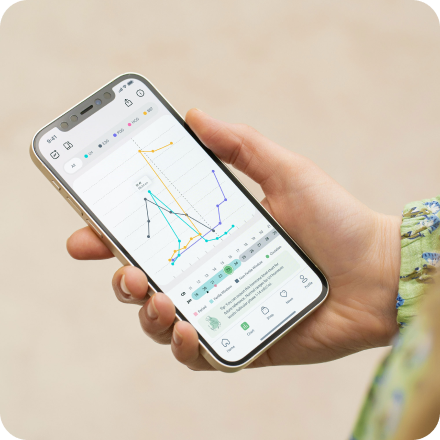Getting Pregnant After 40: Difficulty, Risks, and How to Conceive
We’ve all heard about our so-called “biological clocks” – and if you’re already in your late 30s, you may be feeling like yours is rapidly ticking away. But despite pressure from family, friends, and society to have children ASAP, it’s important to recognize that it’s still possible to have a healthy pregnancy even in your 40s.

In fact, more and more individuals are waiting to have children until they are a bit older. The reasons why can vary, but typically it’s so they can take time to prioritize their career, travel the world, or establish some stability before starting a family.
If this resonates with you and your situation, read on to learn more about your chances of getting pregnant later in life, strategies for boosting your fertility, and medical considerations to make while trying to conceive (TTC).
What is a Geriatric Pregnancy?
“Geriatric pregnancy” is an outdated term used to describe pregnancies in individuals over the age of 35. Nowadays, doctors prefer to use the term “advanced maternal age” or “AMA” pregnancies.
Doctors give AMA pregnancies this special distinction because of the risks associated with them. This includes an increased risk of miscarriage, genetic disorders, preeclampsia, preterm birth, and gestational diabetes – all of which can be managed through additional monitoring, testing, and guidance from a medical professional.
It’s important to note that these risks are only something to be mindful of – not afraid of. It is absolutely possible to conceive, carry, and deliver a healthy baby in your late 30s and 40s. In fact, advanced maternal age (AMA) birth rates in the US have actually steadily increased over the past 30 years.
Factors Influencing Advanced Maternal Age (AMA) Pregnancies
Egg quantity
Ovulating individuals are born with a set number of eggs, and the quantity of these eggs decreases with age.
For example, during puberty, an individual has 300,000 to 500,000 eggs. By age 37, this number decreases to 25,000 eggs — and by age 51, most individuals have fewer than 1,000. Unfortunately, because not all of these eggs will be healthy enough to support a pregnancy, the “true” number of viable eggs is much lower than that.
With fewer viable eggs available, this can make getting pregnant in the first place a challenge for many couples. For some, getting pregnant will require careful fertility planning, monitoring, and even extra help from assisted reproductive technologies (ARTs).
Egg quality
Everyone who ovulates has some eggs that are genetically abnormal. Sometimes, this means that they will be unable to produce a viable pregnancy. Other times, this means that although the egg is fertilized, the baby will experience genetic health problems.
When we are young, some of our eggs will have genetic abnormalities, but most of them will be healthy. However, by age 40, this ratio flip-flops, leaving us with more genetically abnormal eggs than healthy ones. Experts estimate that after age 40, less than half of a woman’s eggs are considered “normal.”
With more genetically abnormal eggs available for fertilization, this puts the pregnancy at a greater risk of birth defects and miscarriage. To reduce this risk, many individuals choose to freeze their eggs in their 20s and 30s so that they can plan for future pregnancies later in life.
Age-related health concerns
As your body ages, you are more likely to develop medical conditions such as high blood pressure, obesity, or diabetes. These conditions can then increase your risk of experiencing complications during pregnancy.
The best way to prevent these complications from impacting your pregnancy is to undergo a health screening with your doctor. They can then provide advice on the best ways to mitigate these risks during pregnancy.
Chances of Getting Pregnant After 35
Natural conception
At the age of 35, the chances of conceiving naturally within any given cycle are 15-20%, with chances rapidly declining after 37. By 40, the chances of getting pregnant each cycle are less than 5%, and these chances continue to decline into your 40s.
Assisted reproductive technologies (ARTs)
Chances of conception after the age of 35 are higher with the help of assisted reproductive technologies (ARTs) – such as in-vitro fertilization (IVF) and intrauterine insemination (IUI).
According to the Center for Disease Control (CDC), IVF success rates among patients with no prior ART experience and using their own eggs in 2020 were:
- Ages 35-37: 40.5%
- Ages 38-40: 26.4%
- Ages 40+: 8.1%
If you are curious about what your potential chances of success could be with IVF, check out the CDC’s IVF Success Estimator.
Risks Associated With Advanced Maternal Age (AMA) Pregnancies
Preeclampsia
Individuals who become pregnant after the age of 35 are at an increased risk of developing high blood pressure and/or preeclampsia during pregnancy, especially if it is their first pregnancy.
Preeclampsia is a pregnancy complication resulting in high blood pressure and possible damage to organs. Symptoms of preeclampsia include weight gain due to fluid retention, belly pain, severe nausea, and severe headaches. These symptoms can appear as early as 20 weeks or during delivery.
The best way to reduce your risk of preeclampsia is to stay hydrated, exercise regularly (with your doctor’s approval), and elevate your feet a few times a day. It’s also recommended to avoid foods that are fried, processed, or high in salt.
Birth defects
As we age, the risk of an egg having a genetic abnormality increases, and therefore, the risk of having a pregnancy with a birth defect also increases.
One of the most well-known birth defects affecting the chromosomes is Down syndrome. By the age of 40, the odds of giving birth to a baby with Down syndrome are 1 in 70; by age 45, the odds increase to 1 in 19.
Miscarriage
The risk of miscarriage in individuals over the age of 40 is nearly 50%, more than triple that of individuals in their 20s. Most miscarriages occur because of abnormalities in the fetus, many of which are genetic. It’s estimated that half of all miscarriages are caused by extra or missing chromosomes.
These problems usually occur by chance when cells duplicate as the fetus grows, rather than genetic abnormalities inherited from a parent. Unfortunately, these errors appear to become more common as egg quality declines with age.
Low birth weight
Individuals over the age of 40 are at a significantly higher risk of giving birth to a baby with a low birth weight. The most common causes of low birth weight are premature birth (birth before 37 weeks gestation) and fetal growth restriction.
Individuals over the age of 35 should be aware of this risk factor and make sure to follow the prenatal advice from their doctor.
Ectopic pregnancy
Individuals over 40 are at the highest risk of having an ectopic pregnancy. An ectopic pregnancy occurs when a fertilized egg implants itself outside of the uterus, most often in the fallopian tubes.
Unfortunately, ectopic pregnancies cannot be prevented. However, it’s important to stay in tune with your body and report any concerning symptoms promptly to your doctor.
Gestational diabetes
Gestational diabetes is new-onset diabetes occurring during pregnancy. Compared with individuals ages 20 to 29, those in their 40s are three to six times more likely to develop gestational diabetes. If left untreated, gestational diabetes can lead to complications in the infant, including stillbirth.
According to the CDC, the best way to reduce the risk of gestational diabetes is to maintain a healthy diet, try to stay physically active, and check your blood sugar regularly if necessary.
Pregnancy After 40
Over the age of 40 and pregnant? Congratulations! You’re among a growing group of individuals who are navigating pregnancy after 40.
You may be feeling a little apprehensive or scared, but it’s important to relax and remind yourself that getting pregnant after 40 is normal.
Here are a few tips for setting your pregnancy up for success:
- If you’re not already, start taking a prenatal vitamin immediately.
- Book an appointment with your doctor to assess your risks and create a pregnancy plan.
- Stop consuming alcohol and tobacco products.
Pregnancy can be a very emotional period, so it’s important to be kind to yourself, prioritize sleep, and allow yourself plenty of time to unwind.

Mira Founder, Sylvia Kang’s Story
Mira’s own founder, Sylvia Kang, recently opened up about her experience of postponed motherhood in an interview with Vogue.
Speaking about fertility, Sylvia said, “For some people, getting pregnant after 35 will become harder and may have more complications. The truth is, fertility does not decline in one day. Keeping a healthy lifestyle and monitoring your fertility health are good things to do to get prepared.”
She also shared some advice for those TTC, “Try to not to over-stress and seek help when needed. The fertility and pregnancy journey is never as easy as we may have thought. Don’t blame or push yourself too much. Seek help from doctors to identify the problem as clearly as possible and trust that your body will do the rest of the work.”
Read the full article from Vogue: Pregnant after 35: Mira founder, Sylvia Kang on postponed motherhood and how she aims to join the dots in fertility.
How to Increase Fertility After 35
If you are actively seeking to plan a pregnancy after 35, it’s worth taking stock of your lifestyle and health situation. This will empower you to make any necessary lifestyle changes to help maximize your chances of conception.
Check-in with your doctor
We recommend booking a pre-pregnancy checkup with your doctor. They can assess your situation and help you identify any potential health concerns that could affect your pregnancy. They will also be able to provide insights into the risks associated with getting pregnant later in life and how to mitigate them.
Have sex at the right time
The average fertile window only lasts up to six days each cycle, with the day before ovulation and the day of ovulation being the days where you are the most likely to get pregnant. In order to plan a pregnancy, it is absolutely crucial to have sex during this time in order to conceive.
There are a number of different strategies and tools you can use to predict ovulation – some of the most popular include the basal body temperature (BBT) method, cervical mucus method, ovulation predictor kits (OPKs), and the classic calendar method.
One of the most accurate ways to pinpoint ovulation is by tracking your hormones regularly. This can be done at a doctor’s office, or, you can use an at-home fertility tracker like Mira. Mira is a particularly useful tool if your cycle is longer/shorter than average, or, if you have a hormonal condition such as polycystic ovarian syndrome (PCOS).
Live a healthy lifestyle
Lifestyle can have a major impact on your ability to get pregnant at any age, especially if you are over the age of 35.
To boost fertility and increase your chances of having a healthy pregnancy, consider the following tips:
- Take a prenatal vitamin with folic acid, calcium, and iron.
- Maintain a healthy weight by eating a balanced, nutrient-rich diet and staying active.
- Get plenty of sleep, most adults need at least eight hours each night.
- Keep stress levels to a minimum by setting healthy boundaries and taking time to relax.
- Avoid tobacco products, alcohol, and drugs while TTC.
If you are struggling to balance your lifestyle while TTC, consider seeking additional help from a doctor or counselor.
Take the Quiz!
Tell us your fertility goal and we'll give you a perfect product match
Medical Considerations for Advanced Maternal Age (AMA) Pregnancies
Preconception Care Checklist
Think of preconception care as a way to set yourself up for success. Here is a checklist for maximizing your chances of conception:
- Establish goals, timelines, and expectations with your partner
- Book yourself a pre-pregnancy checkup with your doctor
- Book your partner a pre-pregnancy checkup with their doctor (and consider sperm testing)
- Book an appointment for genetic counseling and screening
- Make any necessary nutrition and lifestyle changes for a healthy body and hormones
- Gather the necessary tools to predict ovulation and time intercourse
- Purchase a prenatal vitamin and ask your doctor about which fertility supplements are right for you
It’s important to note that the TTC process can feel stressful and daunting. Try to stay positive and kind to yourself during this time. You’ve got this!
Prenatal Care Checklist
Once you’re pregnant, there are additional medical considerations to make. Here is a checklist to keep on hand for prenatal care:
- Book an appointment with your doctor to confirm pregnancy
- Undergo any necessary specialized tests and screenings for AMA pregnancies
- Continue to stay active and eat a balanced diet
- Avoid potentially harmful foods including raw meat and seafood, unpasteurized milk and milk products, and undercooked eggs – see the full list from foodsafety.gov
- Quit smoking and consuming alcohol
- Monitor your body and report any concerning symptoms to your doctor – see the CDC website for a full list of symptoms
- Explore the available birthing and prenatal classes in your area
- Make a birthing plan with your partner and healthcare provider
Remember – no two pregnancies are alike. While it can be tempting to compare yourself to others, try to stay focused on yourself. This is the best way to keep your stress levels under control for a happy and healthy pregnancy.
How to Recover From Pregnancy After 40
Giving birth to a child is one of the happiest and most traumatic events that an individual can experience. When recovering from an AMA pregnancy, it’s important to be patient and allow yourself time to heal both physically and mentally.
While every family is different, here are just a few considerations to make after giving birth:
- Rest is the #1 priority. Don’t give in to pressure from family or friends who want to visit. There will be plenty of time for visitors when you have recovered.
- Ask for help if you need it. Whether you have an awkward question for a nurse or you need help prepping meals for your family, reach out to others for support. They are always more than happy to help.
- Prepare for some crazy hormones. Your hormones will be all over the place after giving birth, and this can be difficult to cope with. If feelings of extreme sadness or anxiety persist for more than two weeks, seek additional mental health support from your doctor.
If this is your first pregnancy, the postpartum period will be an entirely new (and oftentimes overwhelming) experience. If it’s your second, third, or even fourth pregnancy, you may notice that your body feels completely different after pregnancy than it did when you were younger – and that’s okay!
The bottom line is that no matter how you feel, remember that you are not alone on this journey. There are over 100 million births per year, with millions of new parents struggling to navigate the postpartum process. We’re in this together, and you’re doing a great job!
If you need additional support during the postpartum period, we recommend exploring the resources and services available at Postpartum Support International.
Mira’s Editorial Process
All content produced by Mira meets stringent editorial standards, ensuring excellence and accuracy in language and medical precision. Every piece undergoes thorough fact-checking and review by qualified professionals. Check out our full editorial process to learn more.













